Introduction
Introduction to Germany
Overview
Germany is located in Europe and it is considered one of the most prosperous nations in this part of the world. It is a federal parliamentary republic that is made up of 16 semi- autonomous states (Fulbrook 23). The capital city of the nation which also serves as the political, economic and cultural center is Berlin. It is also the largest city in the country.
As of the year 2010, the population size of this nation stood at 82.3 million (Fulbrook 23). This makes Germany the most populous member of the European Union, the economic bloc to which it belongs. It is also regarded as a major political power and one of the most technologically advanced nations in Europe.
History
This country has a very long history dating back several centuries. However, contemporary historians are of the view that the current Germany state can be traced back to the year 1814 after the fall from power of Napoleon I, a man who has ruled France and the neighboring territories with an iron fist for a very long time (Boyes 10).
After his fall from power, the Congress of Vienna came together in the year 1814 to form what came to be known as the German Confederation (Philpott 245). This is also referred in some quarters as the Deutscher Bund.
The confederation brought together 39 autonomous states that were hitherto operating independently. However, there were periodic disagreements among the member states regarding the restoration politics that were advocated to ensure the smooth running of the confederation.
The history of this country is marked by intermittent conflicts and revolutions. For example, the country was actively involved in both the first and the second world wars. In World War I, this country suffered a great loss having lost more than two million soldiers.
In 1918, the country went through the infamous German Revolution which led to the creation of the Germany republic. At some point, the country was divided into two entities which were informally referred to as West and East Germany. The western part of the entity was allied to the western nations of France, United Kingdom and the United States of America while the Eastern sector was allied to the Soviet Union.
Population
As indicated above, the population of this country was approximately 82,329,758 as of the year 2010 (Fulbrook 35). In the same period, the population growth of the country stood at about -0.053 percent per annum. This means that unlike countries in the developing world which are battling huge population growth, the major concern of this nation is the negative growth in its population size.
It is also noted a large portion of this country’s population resides in the urban centers. As of 2008, Fulbrook (35) is of the view that about 74 percent of citizens in this country was living in the urban areas. As of the year 2010, ethnic Germans made up about 91.5 percent of the total population in the country.
These were followed by individuals of Turkish ethnic groups at 2.4 percent. Protestant is the main form of religion in this country. Boyes (10) is of the view that about 34 percent of the citizens are followers of the protestant Christian faith. Catholics account for about 32 percent of the total population with Muslims accounting for about 3.7 percent of the total population.
Like other developed nations, the literacy levels in this country are quite high. As of the year 2010, literacy level stood at 99 percent while level of school attendance was 100 percent (Philpott 243).
Infant mortality rate stood at 3.99 per 1000 individuals in the year 2010, with life expectancy for men standing at about 75.98 years. The life expectancy for women in this country was quite high than that of men, standing at 82.40 in the year 2010.
Political System
According to Wolf (4), parliamentary form of government is practiced in this nation. Germany can be described as a democratic state with a constitution that protects the rights and freedoms of the individual. The constitution also informs the distribution of powers in a federal form of government.
According to Hopkins (15), the chancellor who is equivalent to a prime minister is the leader of the executive arm of the government. There is a ceremonial president who is the chief of state. The prime minister of the country is elected by the lower chamber of the country’s legislature.
The federal judiciary system of this country can be considered as being fairly independent. It is made up of several structures enshrined in the constitution such as the constitutional court, high courts among others (Blaise 3). The role of the judicial arm in this country is to interpret the constitution and to ensure that the rights and privileges of the citizens are protected.
Germany is a multiparty democracy with several vibrant political parties. The Christian Democratic Union (also referred to as the Christian Social Union) is one of the oldest parties in the country. With 237 seats in the Bundestag, this party is considered to be one of the most influential political entities in Germany. It is currently led by Angela Merkel who also happens to be the current Prime Minister of this country.
Another party referred to as the Social Democratic Party holds 146 seats in the current parliament. This party is not only one of the oldest parties in Germany but also in the world. Currently, the party is led by Sigmar Gabriel who is also credited with promoting the party among the large cities and the industrialized states in this country.
Another political entity in Germany is the Free Democratic Party which draws majority of its supporters from the middle and upper class Protestants in this country. Today, this party which is led by Guido Westerwelle holds 93 parliamentary seats. Other political parties in this nation include The Left, Alliance 90 Greens among others.
Germany Foreign Relations
It is noted that the current Germany nation is significantly different from the Germany that it was during the first and second world wars as far as her foreign relations are concerned. During these wars, Germany was an enemy to many nations such as the United States of America and the United Kingdom.
Today, the country enjoys fairly strong and close ties with other western nations such as the united states of American and United Kingdom. It is also a member of NATO and an active member of the European Union (Niewyk & Nicosia 345).
The country also actively participates in United Nations’ affairs making it one of the key contributors to this body. Another organization to which the nation is affiliated is the Organization for Security and Cooperation in Europe (herein referred to as OSCE).
Economy
This report is going to address the economic situation in Germany today. As such, this aspect of the nation will not be deeply dealt with in this section of the report. However, it is important to mention that the economy of this nation is the fifth largest in the world. This is using purchasing power parity (herein referred to as PPP) as the indicator.
It is the largest economy in Europe, dwarfing other economies such as France in the region. As of the year 2010, Germany was the leading exporter of machinery, technology and household items in Europe. This was made possible by a highly skilled labor force that is to be found in this nation.
However, it is important to note that the economy of this country faces several challenges like other economies in the world despite the fact that it is a fairly large one. One of the challenges is the low fertility rates as identified earlier in this paper. This threatens the sustainability of this economy given the fact that it might run into labor shortage and reduced internal market in the future.
Objectives of the Report
This economic analysis report has several objectives. They are as listed below:
- Analysis of Germany’s macroeconomic indicators
- Analysis of Germany’s fiscal indicators
- Analysis of Germany’s monetary indicators
- Analysis of Germany’s international indicators
- A critical analysis of the problems facing Germany from a business perspective
- A critical analysis of future prospects for businesses in Germany
Macroeconomic Study of Germany
Preamble
In section 1 of this report, the reader was introduced to the economic analysis of Germany which is going to be the major focus of the report. Issues covered included political system of the country, economic situation and demographic data.
The aim of this background information was to provide the reader with an idea of the nation which is going to be the focus of this report. The author also provided the reader with a list of objectives that the report will strive to achieve.
In this section, the reader will provide information on the macroeconomic indicators of Germany. The issues that will be covered in this section include major macroeconomic indicators, fiscal indicators, monetary indicators, international indicators and Germany’s level of foreign exchange reserves.
Major Macroeconomic Indicators in Germany
Real GDP
The Gross Domestic Product (herein referred to as GDP) is a major indicator used to measure the status of a country’s economy (Trading Economics 3). It can be conceptualized as the total value of all goods and services that are produced by the economy in a given period of time.
This value is usually expressed in terms of dollars. According to Blaise (2), it is a measure of the size of the country’s economy expressed in terms of dollars.
On the other hand, real GDP can be conceptualized as the size of the country’s economy after adjustments have been made for price changes (Blaise 3). This means that the inflation or deflation rates are taken into account when computing real GDP. The relationship between GDP and real GDP is vividly illustrated in the equation below:
GDP= Real GDP x Price (adapted from Boyes 10)
As of 2010, the GDP in terms of purchasing power parity for Germany stood at 2.94 trillion US dollars (Central Intelligence Agency [CIA] 8). This makes it the fifth largest economy in the world.
Real GDP Growth Rate
Real GDP growth rate measures the rate of growth of the economy making adjustments for price changes. According to the CIA (3), the real GDP growth rate in Germany for the year 2010 was 3.5 percent. In 2009, the growth was -4.7 percent while it was 0.7 percent in 2008. The figure below represents the growth rate of real GDP in Germany between 2007 and 2011:
Figure 1: Real GDP Growth Rate in Germany
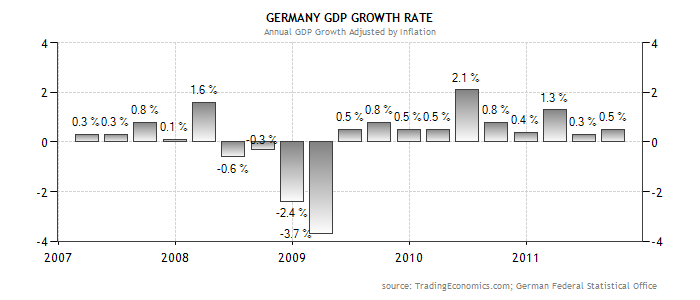
Source: Trading Economics (4)
Rate of Unemployment
Rate of unemployment in any economy can be conceptualized as the percentage of the labor force in that particular economy that is not employed (International Monetary Fund [IMF] 3). In 2010, the rate of unemployment in Germany stood at 7.1 percent according to figures given by the International Labor Organization (ILO). This was a slight improvement compared to the 7.7 percent that was recorded in 2009.
Current Account Balance
IndexMundi (2) views current account balance as “the (economy’s) net trade in goods and services plus net earnings from rents, interest, profits and dividends and net transfers to and from the rest of the world during the period under consideration” (pp2).
It is noted that the figures above are computed using exchange rates as opposed to purchasing power parity.
In 2010, the current account balance for Germany stood at 188.4 billion US dollars. This was a slight decline from the 2009’s estimates of 188.6 billion dollars (IndexMundi 1).
Fiscal Indicators
Ratio of Gross Fiscal Deficit to Nominal GDP
The 2010 budget for this country was marked by a huge fiscal deficit similar to that recorded in other nations in the European Union. The fiscal deficit for the country in 2010 was about €50 billion (Workman 9).
This was about -3.3 percent of GDP according to CIA (21). The country has put measures in place to bring down this ratio to about 0.35 percent of the GDP by the year 2016.
Government Expenditure
The government expenditure in this country was about 1.535 trillion US dollars in 2010 (CIA 22). According to Roubin (237), about 50 percent of the country’s GDP is consumed by the government given the fact that the authorities have to support an expensive social welfare policy.
The public debt for this country in 2010 was about 80 percent of the GDP (Philpott 244). Niewyk & Nicosia (34) puts the average level of government expenditure at about 43.7 percent of GDP.
Revenues
According to the CIA (39), total revenues (tax plus non-tax) for Germany stood at 1.427 trillion US dollars in 2010. The figure below represents the tax revenue for Germany as a percentage of GDP between 1996 and 2008:
Figure 2: Tax Revenue for Germany
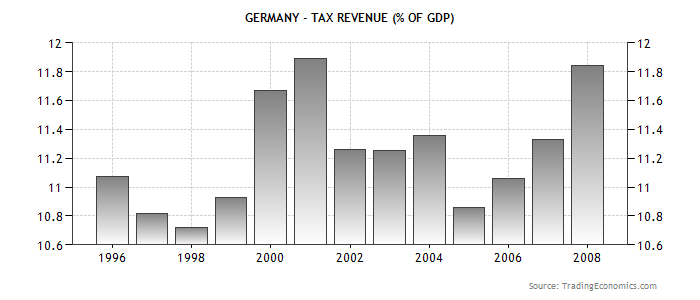
Source: Trading Economics (3)
Monetary Indicators
Growth of Money Supply
The rate at which money supply of an economy grows at is directly related to the rate of inflation in the country. This is given the fact that the government may control the supply of money in the economy in order to control the rate of inflation.
In 2010, the growth of money supply in Germany was at 10.1 percent (World Bank 122). This was similar to the rate of money supply that was evidenced in the early 1990s.
Inflation Rate
As already indicated, the rate of inflation is determined in part by the rate of money supply in the economy. As a result of the current global economic crisis, the rate of inflation in this country is projected to hit the 2.4 percent mark in November 2011.
Between 1992 and 2010, the average rate of inflation in this country was about 1.9 percent (Trading Economics 4). According to CIA (23), the inflation rate was about 1.1 percent in 2010, up from 0.3 percent in 2009. The figure below represents rate of inflation between 2008 and 2011:
Figure 3: Inflation Rate in Germany
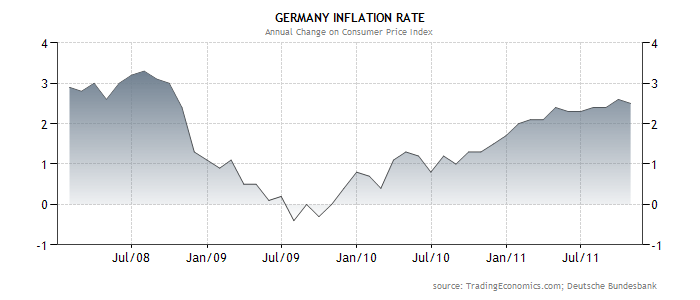
Source: Trading Economics (9)
International Indicators
Openness Index
Openness index can be conceptualized as a measure of the extent to which an economy interacts with other economies in the world. According to the World Bank (133), this is also referred to as the ratio of merchandise trade to the size of the GDP.
In other words, it is the total exports and imports divided by the country’s GDP for that particular period. In 2008, the openness index in this country was 73.20 (Trading Economics 8). The figure below represents the openness index for Germany between 1976 and 2008:
Figure 4: Openness Index for Germany
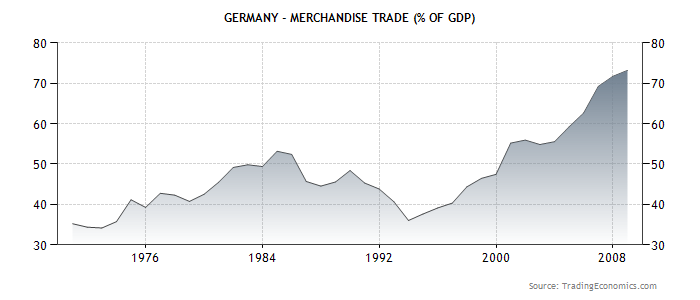
Source: Trading Economics (3)
Growth in Level of Exports
Exports in this country were worth 95 billion Euros as of September 2011 (Trading Economics 2). Germany being the biggest exporter in the world, this form of trade accounts for more than 30 percent of the GDP. The figure below illustrates Germany exports between July 2009 and July 2011:
Figure 5: Exports in Germany
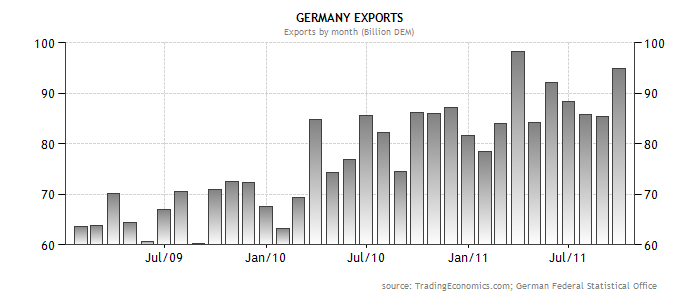
Source: Trading Economics (3)
Growth in Levels of Imports
In 2008, imports in this country were worth about 1.2 trillion US dollars (Workman 5). China accounted for about 6 percent of this figure while the United States of America accounted for about 5 percent (Workman 5). 2010 imports were approximated by the CIA (9) at about 1.099 trillion US dollars. This was up from 972.5 trillion US dollars in 2009.
Level of Foreign Exchange Reserves
KPMG International (4) conceptualizes foreign-exchange reserve as the foreign currency deposits that are held by a country’s central bank and other financial organizations. As of December 31 2010, the level of foreign exchange reserve in Germany was about 216.5 billion US dollars. This was up from 180.8 billion US dollars the previous year (Blaise 4).
Critical Problems in Germany
Preamble
In section 2 of this report, the author provided the reader with an analysis of the macro economy in Germany. Various macroeconomic indicators were analyzed. These included major macroeconomic indicators, fiscal indicators, monetary indicators and international indicators.
In this section, the author will provide the reader with an analysis of the critical problems in Germany. This critical analysis will be based on the macroeconomic study conducted above. The critical analysis will be carried out from a business perspective.
Critical Problems
Slowed Economic Growth
The economic crisis that has swept the world since 2009 has not left Germany unscathed. Philpott (245) reports that the economy of this country has come to a near-standstill during the fourth quarter of 2011. The current global economic slowdown is said to have been the largest contributor to this development.
Between April and June 2011, the largest economy in Europe grew by a paltry 0.1 percent, creating panic in the whole continent (CIA 23). This was a dismal performance given the fact that the economy was projected to grow at about 0.5 percent during this period.
The current crisis in the oil market has also been blamed for the poor performance recorded by the German economy. This is considering the fact that the country is net oil importer. In 2009, the country imported about 2.671 million barrels a day. This is compared to the exports of 470,200 barrels a day made the same year.
Fall in domestic consumption was also blamed for this dismal performance. Energy production also declined within the same period. Coupled with the rise of crude oil prices in the world market, this factor has greatly impacted on the economy.
Declining Population Growth Rate
It is also noted that the population of this country has continued to decrease over the years. This is a major concern for economists and other analysts in this country. In 2011, population growth rate was -0.208 percent according to CIA (9). Birth rate in 2011 was about 8.3 births in every 1000 persons.
This is as compared to death rate as of July 2011 which stood at 10.92 deaths in every 1000 persons. What this means is that the economy might start importing labor in future. This is in addition to shrinking internal market.
Unemployment Rate
The rate of unemployment in this country has been another source of major concern among businesses. It is noted that in 2011, the rate of unemployment stood at 11 percent, up from 7.8 percent the previous year. Whereas this trend may appear good to businesses due to availability of cheap labor, it is not good for the growth of the economy.
Future Prospects for Businesses in Germany
Preamble
In section three above, the author provided the reader with an analysis of critical problems that Germany is facing today. This critical analysis was carried out from a business perspective.
The problems that this country faces as a result of the current global economic crisis and the recent changes in oil prices were analyzed. Three critical problems were identified. These are the slow economic growth, decrease in population growth and unemployment rates in the country.
In this section, the author will provide the reader with an analysis of the future prospects for businesses in this country. This analysis will also be based on the economic analysis that was carried out in this paper.
Future Prospects for Businesses
Slowed Economic Recovery
Businesses should be aware of the fact that the country is recovering slowly from the economic crisis that it went through. However, it should be noted that this is just a short term holdback. Analysts such as Carsten Brzeski of the ING are however optimistic regarding the future of the country’s economy.
He is of the view that the current trend in the economic growth in Germany is an indication of normalization in growth of the economy as it emerges from the throes of the economic meltdown. He is of the view that the economy of the country may still grow by about 3 percent this year (Fulbrook 34).
There are other analysts who do not hold such a positive outlook as far as the economy of the country is concerned. These are of the view that the German economic miracle (also referred to as Wirtschaftswunder) might be coming to an end. They are of the view that the country may go back to an economic recession rather than emerging from it.
However, there is still some hope for businesses in this country as far as the state of the economy is concerned. The Germany government has taken note of these developments and has made some steps to help the economy recover.
Since the year 2009, the constitution of the country has been changed to include policies that are meant to reduce the fiscal deficit in the country. This is through the famous ‘debt brake’ or Schuldenbremse (Fulbrook 98).
This is aimed at reducing the deficit of government spending to a maximum of 0.35 percent of the GDP. This is by the year 2016. The policy goes further to state that state governments in this country will not be allowed to run deficits at all starting from 2020. This development shows that the future is bright for businesses in this country.
Germany’s Foreign Policy
It is noted that the foreign policy of this country has being improving over the years. Starting January 2011, Germany was elected to serve as a temporary member in the UN Security Council. It is also noted that there are strong trade ties between Germany and other nations around the world.
This is very important for multinationals operating in this country and other businesses that are involved in exports and imports of goods and services in the country.
However, analysts are of the view that the economy of this country relies heavily on exports. This is so considering the fact that this country is the leading exporter in the world. This being the case, the country’s GDP is very vulnerable to changes in the international market.
Population Growth and Future of Businesses in this Country
Another point that should be taken into consideration by businesses operating in this country is the fact that the population of this country is shrinking. This is both positive and negative to the country’s economy. The social welfare of the citizens is likely to increase since the government can easily manage the small population.
However, this might be a challenge to businesses operating here. The size of the internal market may reduce. This means that the businesses may be forced to export their goods and services while importing labor in the future.
Conclusion
This report found that Germany has the largest economy in Europe. However, the report found that the economy of this country has being growing at a very small rate in the recent past. This slow growth has negatively affected the whole euro zone economy.
Inflation rate was found to be 1.1 percent as of 2011. The country has a significant foreign exchange reserve as compared to other economies in the region.
Some of the problems that are faced by this country include slow economic growth as mentioned above, reduced rate of population growth and unemployment rates. Being a net oil importer, this country is vulnerable to changes in the price of oil in the world market.
This report notes that the future is bright for businesses operating in this country. This is given the fact that the government has taken measures aimed at improving the economy.
The foreign relations between Germany and other countries have also improved over the years. However, there are some challenges such as the reduced population growth that businesses have to contend with.
Works Cited
Blaise, Robinson. Sluggish German GDP Derails European Stock Rebound. Reuters. Web.
Boyes, Peter. Germany in the 21st Century. New York: Free Press, 2011.
Central Intelligence Agency. The World Fact Book. Web.
Fulbrook, Mary. A Concise History of Germany. Cambridge: Cambridge University Press, 2011.
Hopkins, Kathryn. Germany Officially in Recession as OECD Expects US to Lead Recovery. The Guardian. Web.
IndexMundi. Germany Unemployment Rate. IndexMundi. Web.
International Monetary Fund. World Economic Outlook. International Monetary Fund, September 2011.
KPMG International. Country Focus- Germany. KPMG International, Fall 2010.
Niewyk, Donald L., & Nicosia, Francis R. The Columbia Guide to the Holocaust. Columbia: Columbia University Press, 2010.
Philpott, Newton. Germany in Europe. London: Free Press, 2011.
Roubin, Peter. Germany: Fiscal Policy. Global Economics. Web.
Trading Economics. Tax Revenue in Germany. Trading Economics. 2011. Web.
Wolf, Martin. Europe Needs German Consumers. Financial Times. 2010. Web.
World Bank. World Development Indicators 2009. New York: World Bank, 2010.
Workman, Daniel. Germany’s Top Exports and Imports in 2008. International Trade. 2009. Web.